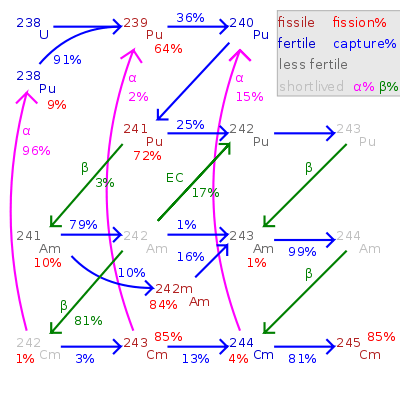Fertile material

Fertile material is a material that, although not itself fissionable by thermal neutrons, can be converted into a fissile material by neutron absorption and subsequent nuclei conversions.
Naturally occurring fertile materials
Naturally occurring fertile materials that can be converted into a fissile material by irradiation in a reactor include:
- thorium-232 which converts into uranium-233
- uranium-234 which converts into uranium-235
- uranium-238 which converts into plutonium-239
Artificial isotopes formed in the reactor which can be converted into fissile material by one neutron capture include:
- plutonium-238 which converts into plutonium-239
- plutonium-240 which converts into plutonium-241
Some other actinides need more than one neutron capture before arriving at an isotope which is both fissile and long-lived enough to probably be able to capture another neutron and fission instead of decaying.
- plutonium-242 to americium-243 to curium-244 to curium-245
- uranium-236 to neptunium-237 to plutonium-238 to plutonium-239
- americium-241 to curium-242 to curium-243 (or, more likely, curium-242 decays to plutonium-238, which also requires one additional neutron to reach a fissile nuclide)
Since these require a total of 3 or 4 thermal neutrons to eventually fission, and a thermal neutron fission generates only about 2 to 3 neutrons, these nuclides represent a net loss of neutrons. In a fast reactor, they may require fewer neutrons to achieve fission, as well as producing more neutrons when they do fission.
Fissile materials from fertile materials
A fast-neutron reactor, meaning one with little or no neutron moderator and hence utilising fast neutrons, can be configured as a breeder reactor, producing more fissile material than it consumes, using fertile material in a blanket around the core, or contained in special fuel rods. Since plutonium-238, plutonium-240 and plutonium-242 are fertile, accumulation of these and other nonfissile isotopes is less of a problem than in thermal reactors, which cannot burn them efficiently. Breeder reactors using thermal-spectrum neutrons are only practical if the thorium fuel cycle is used, as uranium-233 fissions far more reliably with thermal neutrons than plutonium-239.
Applications
Proposed applications for fertile material includes a space-based facility for the manufacture of fissile material for spacecraft nuclear propulsion. The facility would notionally transport fertile materials from Earth, safely through the atmosphere, and locate them at a space facility at the Earth–Moon L1 Lagrangian point where manufacture of fissile material would occur, eliminating the safety risk of transport of fissile materials from Earth.[2]
References
- ↑ Sasahara, Akihiro; Matsumura, Tetsuo; Nicolaou, Giorgos; Papaioannou, Dimitri (April 2004). "Neutron and Gamma Ray Source Evaluation of LWR High Burn-up UO2 and MOX Spent Fuels". Journal of Nuclear Science and Technology. 41 (4): 448–456. doi:10.3327/jnst.41.448.
- ↑ Dodd, Jake; Thangavelu, Madhu (January 2012). "SNAP-X: The Space Nuclear Activation Plant". AIAA Space 2012 (Conference issue). doi:10.2514/6.2012-5329. Retrieved 2012-12-18.